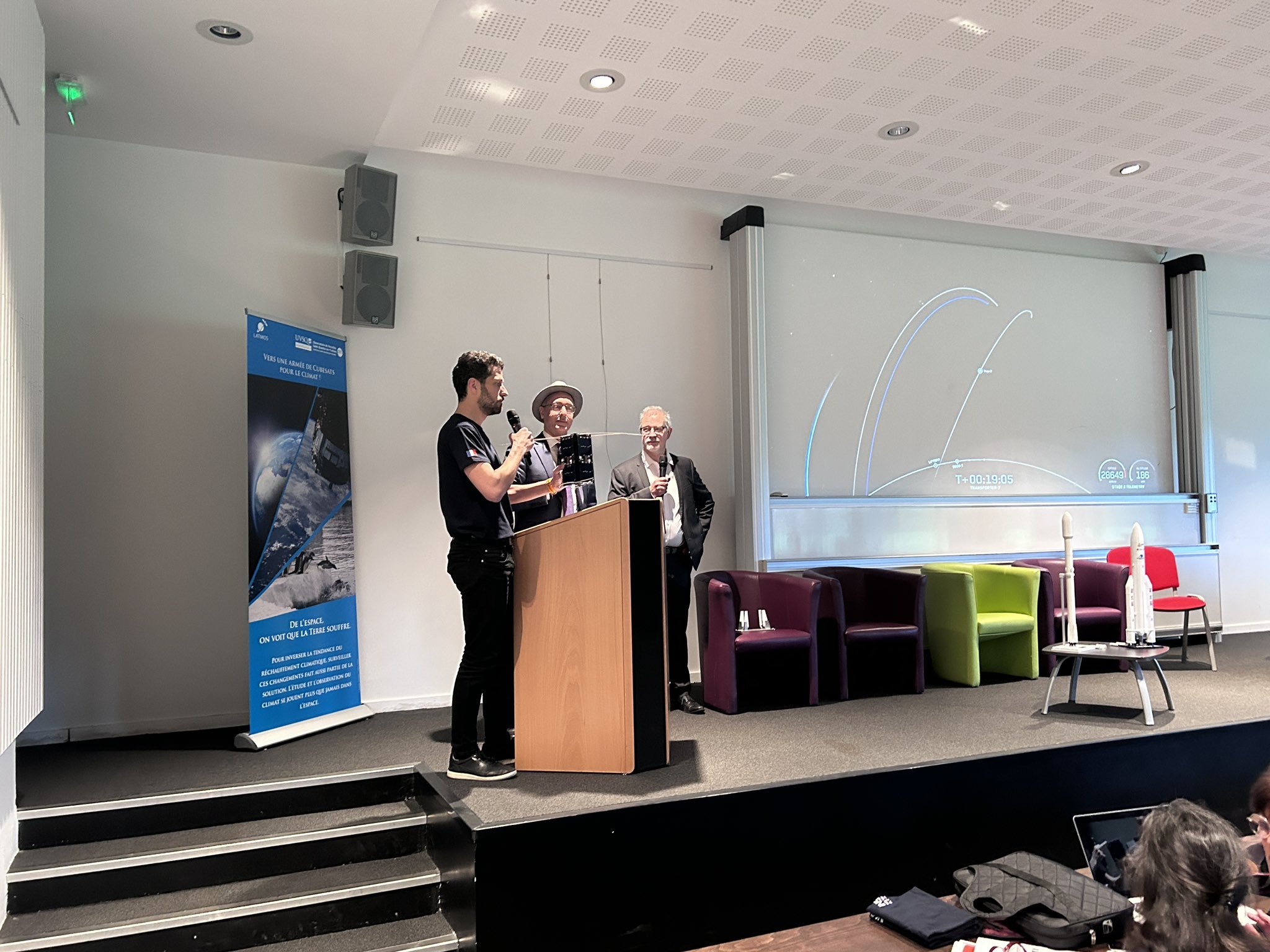Table of Contents
The INSPIRE-SAT 7 Nanosatellite, Integrated with OLEDCOMM's LiFi Module, SatelLife, Has Been Successfully Launched Into Space and Will Join the Nanosatellite UVSQ-SAT
Photo Credit to University of Versailles Saint-Quentin-en-Yvelines (UVSQ)
INSPIRE-SAT 7 Nanosatellite
On Saturday 15th April 2023, INSPIRE-SAT 7 nanosatellite has finally been launched into space with SpaceX from California. This was launched by a SpaceX Falcon9 rocket from the base in Vandenberg, California. The Launch suffered a four-day delay from the original schedule (11th April 2023), in order to allow time for additional pre-launch checkouts as well as improved weather conditions. This was the 24th launch of the year for SpaceX.
The mission lifted off on Friday, April 14, 2023, at 11:47 PM PDT (06:47 UTC on April 15).
Transporter-7 is the 1st SpaceX Transporter rideshare mission to launch from Vandenberg Space Force Base. Transporter 7 mission is a dedicated rideshare flight to a sun-synchronous orbit with dozens of small microsatellites and nanosatellites for commercial and government customers.
Credit to EXOLAUNCH
Oledcomm states that LiFi offers key benefits for space missions such as an ultra-secure and interference-free wireless connection, and significant weight savings by eliminating radiation-resistant space-grade cables and connectors, at extremely low energy consumption.
INSPIRE-SAT 7 is a French nanosatellite designed to observe the Sun and the Earth. INSPIRE-SAT 7 will join UVSQ-SAT, which has been technically and scientifically operational since January 2021. The deployment of this second satellite marks the second step in the creation of the first constellation of CubeSats dedicated to the observation of essential climatic variables. This new space technology demonstrator is placed under the responsibility of LATMOS (Laboratory Atmospheres, Environments, Spatial Observations – UMR8190 CNRS, UVSQ, Sorbonne University). Close collaboration has been set up with ONERA, national and international academic partners, and industrialists in the Ile-de-France region.
You can rewatch the transporter 7 Mission Space launch on the link below from Space X YouTube channel:
Inspire-Sat 7 is a French nanosatellite designed to observe the sun and the Earth. Twice as large as a 4x4 Rubik's Cube, it weighs around 2 kg and is made up of "Cubesat" (or units). Inspire- Sat 7 is also equipped with multiple miniaturised sensors to measure essential climatic variables and test new technological devices. It will be put into low orbit, that is to say about 500 km from the Earth, from the American launcher Falcon9 from SpaceX.
The Inspire-Sat 7 mission, involving French actors, will be launched by a SpaceX Falcon9 rocket from the base in Vandenberg, California.
Photo credit to Université de Versailles Saint-Quentin-en-Yvelines
Photo credit to Université de Versailles Saint-Quentin-en-Yvelines
Oledcomm
Oledcomm designs and develops LiFi network interface devices that enable high-speed wireless data communication. It also serves LiFi equipment in the telecom, datacom, personal electronics, and industrial markets. The company’s product portfolio includes hubs, routers, switches, adapters, drivers, power supplies, and more.
Oledcomm was founded in 2012 and is based in Paris, France. Oledcomm's adventure began in 2005 in the research laboratories of the University of Versailles-Saint-Quentin with the first work on communication by visible light.
Following years of research & development and a passion for innovation, Oledcomm became the pioneer of LiFi (Light Fidelity) solutions and innovation on a global scale.
Based in the Paris region, Oledcomm employs around 20 people and designs complete solutions for LiFi operation, including microcontrollers, LiFi photoreceivers and software platforms.
Today, after more than 33 patents, 15 years of R&D, over 500 trusted clients and several awards, Oledcomm is pursuing a strong mission: to transform the 14 billion points of light in the world into a powerful communication network.
The company is ISO 9001:2015 and ISO 14001:2015 certified. Oledcomm's LiFi offering solves connectivity problems by replacing cables in environments where radio waves are undesirable. Targeted sectors include space, defence, industrial and education. Since 2020, LiFiMAX® has been installed and tested in more than 800 projects worldwide and has been validated by ORANGE for Cybersecurity.
At the Mobile World Congress in Barcelona in 2021, Oledcomm announced an integrated circuit (ASIC) that enables native LiFi integration in tablets, PCs or smartphones. Oledcomm is a laureate of the European Deeptech EIC Accelerator program, which provides for the European Commission to invest in Oledcomm through the EIC Fund.
What is LiFi?
LiFi, also known as "Light Fidelity" is a wireless optical networking technology, which uses light-emitting diodes (LEDs) to transmit data. In 2011, professor Harald Haas made a LiFi demonstration at the TED (Technology, Entertainment, Design) Global Talk on Visible Light Communication (VLC).
VLC uses light as a medium to deliver high-speed communication like Wi-Fi and complies with the IEEE standard IEEE 802.15.7. The IEEE 802.15.7 is a high-speed, bidirectional, and fully networked wireless communication technology-based standard similar to Wi-Fi's IEEE 802.11.
How does LiFi work?
LiFi is a high speed, bidirectional, and fully networked wireless communication of data using light. LiFi constitutes of several light bulbs that form a wireless network.
When an electrical current goes through to a LED light bulb, a stream of light (photons) emits from the lamp. LED bulbs are semiconductor devices, which means that the brightness of the light flowing through them can change at extremely high speeds. The signal is sent by modulating the light at different rates. The signal can then be received by a detector that interprets the changes in light intensity (the signal) as data. Also when the LED is ON, you transmit a digital 1, and when it is OFF, you transmit a 0.
LiFi Benefits
The primary benefits of LiFi are as follows:
• Security: Provides entirely secure access. Where there is no light there is no data.
• Safety: Does not produce electromagnetic radiation and does not interfere with existing electronic systems.
• Localisation: Allows localisation due to the small coverage area of LiFi access point - localisation can be used for very precise asset tracking.
• Data density: Provides ubiquitous high-speed wireless access that offers substantially greater data density (data rate per unit area) than RF through high bandwidth reuse.
Credit to Oledcomm
LiFi Applications
LiFi can be used for so many applications and the list is increasing every year. You can read our updated list of Li-Fi applications at the following link:
Credit to pureLiFi
LiFi Systems Reviews by LiFi Tech News
OLEDCOMM LIFIMAX KIT REVIEW - ONE YEAR IN
We reviewed the LiFiMax kit produced by the leading French LiFi company Oledcomm. We bought this LiFi kit system at the end of 2020. After over a year of use, we decided to write a review of this LiFi system. We looked briefly at the profile of Oledcomm, a brief history of the LiFiMax system, the Kit box contents, some testing and performance results of this LiFi system, the customer experience and our own verdict (the good and the bad points) of the LiFiMax kit.
You can read the review on this link:
https://www.lifitn.com/blog/lifimaxreview
SIGNIFY TRULIFI 6002.1 STARTER KIT SYSTEM REVIEW
We also reviewed the Trulifi 6002.1 starter kit produced by Signify, the world leader in lighting for professionals, consumers and lighting for the Internet of Things. We got this LiFi kit system with the help of PCDSI and Signify around August 2021. In a similar fashion done with our previous review of the LiFiMax kit a few months ago, we will look briefly at the profile of Signify, a brief history of the Trulifi 6002.1 kit, the Kit box contents, some testing and performance results of this LiFi system, the customer experience and our own verdict (the good points and the bad points) of the Trulifi 6002.1 kit.
You can read the review on this link:
https://www.lifitn.com/blog/trulifi6002review
In conclusion, if you are also interested to hear more information about the OWNII Coin or enquire about LiFi devices such as the LiFiMax and Trulifi, you can contact us through our chatbot or by sending an email through our contact us form. If you enjoyed this post and would like to hear more updates about LiFi technology, subscribe to our newsletter. Don’t forget to subscribe to our social media accounts. You can also join our Telegram group about LiFi technology on this link:
https://t.me/joinchat/FMzOmsEKyJFrU6Af









